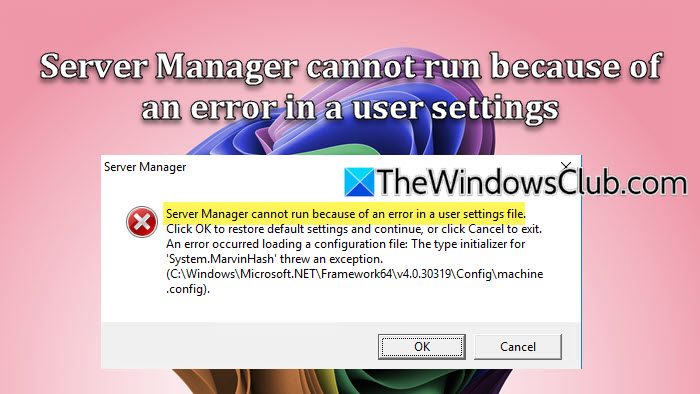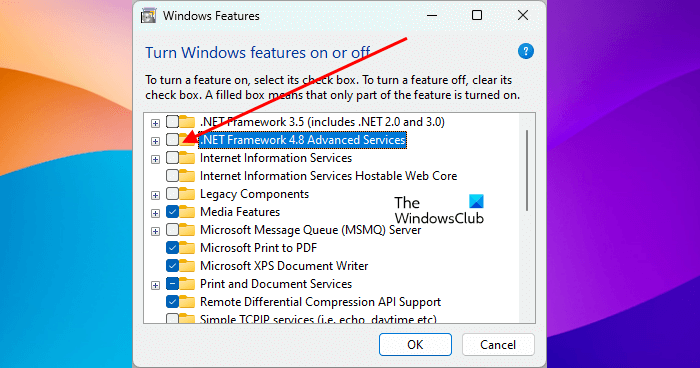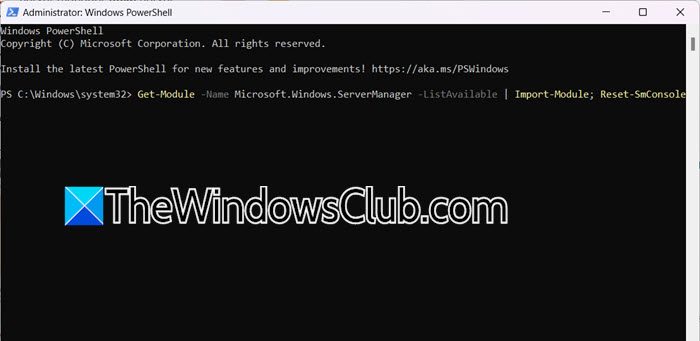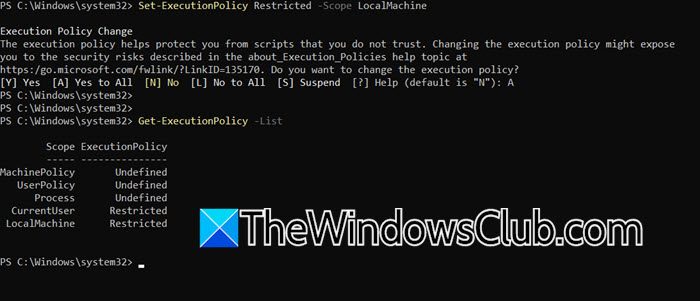Server Manager of Windows Server allows you to manage all your resources, active directories, clusters, and more. However, we have noticed that on some machines, especially after renaming the name of the system, the Server Manager starts crashing and says Server Manager cannot run because of an error in a user settings file. This post will discuss this issue and see how you can resolve it.

Server Manager cannot run because of an error in a user settings file.
Click OK to restore default settings and continue, or click Cancel to exit.
An error occurred loading a configure file: The type initializer for ‘System.MarvinHash’ threw an exception (path-of-conf-file.config)
Fix Server Manager cannot run because of an error in a user settings file
If the Server Manager cannot run because of an error in a user settings file, follow the solutions mentioned below.
- Repair or reinstall .NET Framework
- Restart Server Manager
- Set Execution Policy
- Check the configuration file
- Rename the computer to its predecessor
Let us talk about them in detail.
1] Repair or reinstall .NET Framework

The .NET Framework is an essential tool that provides an environment for software written using the .NET programming language, like Server Manager, to run. So, to resolve the issue, we recommend you try to repair or reinstall the .NET Framework. To do this, we need to follow the solutions.
- Open the Control Panel by searching it out of the Start Menu.
- Click on Program and Features > Turn Windows features on or off.
- Untick .NET Framework 3.5 (includes .NET 2.0 and 3.0) and .NET Framework 4.8 Advanced Services.
- Click OK and then reboot the computer.
- Open Turn Windows features on or off prompt by following the first two steps.
- Then tick .NET Framework 3.5 (includes .NET 2.0 and 3.0) and .NET Framework 4.8 Advanced Services and click OK.
Once done, check if the issue is resolved.
2] Restart Server Manager

You may also encounter this issue if the Server Manager glitches. So, we will restart the Server Manager along with a few of its components and then see if the issue is resolved. To do so, open the Task Manager, right-click on Server Manager, and click on End Task. Now, open the Server Manager as an administrator and see if the issue is resolved.
But if it persists, open the Services app, look for the Server Manager service, and start it if it’s not running; if it is running, restart the service.
Also, reset the Server Manager console by running the following command in PowerShell.
Get-Module -Name Microsoft.Windows.ServerManager -ListAvailable | Import-Module; Reset-SmConsole
Finally, check if the issue is resolved.
3] Set Execution Policy

An execution policy in PowerShell is a security feature that controls the conditions under which PowerShell loads configuration files and runs scripts. To resolve the issue, we are going to set it to the default, which is Restricted. To do so, open PowerShell as an administrator and execute the following command.
Set-ExecutionPolicy Restricted -Scope LocalMachine
If when doing so, you get an error message that says Windows PowerShell updated your execution policy successfully, but the setting is overridden by
a policy defined at a more specific scope, you need to set the policy for the current user as well, for that, run – Set-ExecutionPolicy Restricted -Scope CurrentUser.
The command will set the execution policy to Restricted.
If you want to verify it, run – Get-ExecutionPolicy -List.
You will see the list of scopes and their respective Execution Policy.
Read: Windows Server Manager not opening or working
4] Check the configuration file
The machine.config file holds configuration settings that apply to all .NET Framework applications on the machine. This provides a centralized approach to managing configurations for all .NET applications, including Server Manager, running on the system.
Also, if you are using an outbound proxy to connect to the internet, you must add a specific setting to the C:\Windows\Microsoft.NET\Framework64\v4.0.30319\Config\machine.config file. This step is essential for the installation wizard and Azure AD Connect sync to connect properly to the internet and Azure Active Directory (Azure AD).
However, we are not going to add the text straightaway there, we recommend you first delete C:\Users\YourUserName\AppData\Local\Microsoft_Corporation\ServerManager.exe_StrongName_m3xk0k0ucj0oj3ai2hibnhnv4xobnimj\10.0.0.0\user.config file, then reboot your computer and see if your issue persists.
If you still encounter the same issue, append the following line of code to the file.
<system.net> <defaultProxy> <proxy usesystemdefault="true" proxyaddress="http://<PROXYADDRESS>:<PROXYPORT>" bypassonlocal="true" /> </defaultProxy> </system.net>
Note: Replace <PROXYADDRESS> with the actual Proxy IP or hostname and <PROXYPORT> with the port of the proxy.
Once done, reboot your computer and see if the issue is resolved.
5] Rename the computer to its predecessor
If editing the configuration file didn’t resolve the issue, we recommend you rename the computer to its predecessor. You can also go to C:\Users\Administrator\AppData\Roaming\Microsoft\Windows\ServerManager, look for ServerList.Xml, and then see it is pointing to a different name; you can then revert it back to a common name and then see if that helps.
Hopefully, you can resolve the issue using the solutions mentioned in this post.
Read: How to install DHCP server in Windows Server?
How to enable server manager?
The Server Manager is preinstalled on your computer. To access it, open Run, type ‘server manager‘, and click on OK. You can also open it by searching for it in the Start Menu.
Read: Windows Server Manager not opening or working
How to check server running in cmd?
To check if the server is running in the Command Prompt by pinging the server. You can run ping <hostname> or ping <IP-address> to see if you can send packets to the server. Also, check the active connections using netstat -an | find "LISTEN".
Also Read: ServerManager.exe – This application could not be started.
Leave a Reply